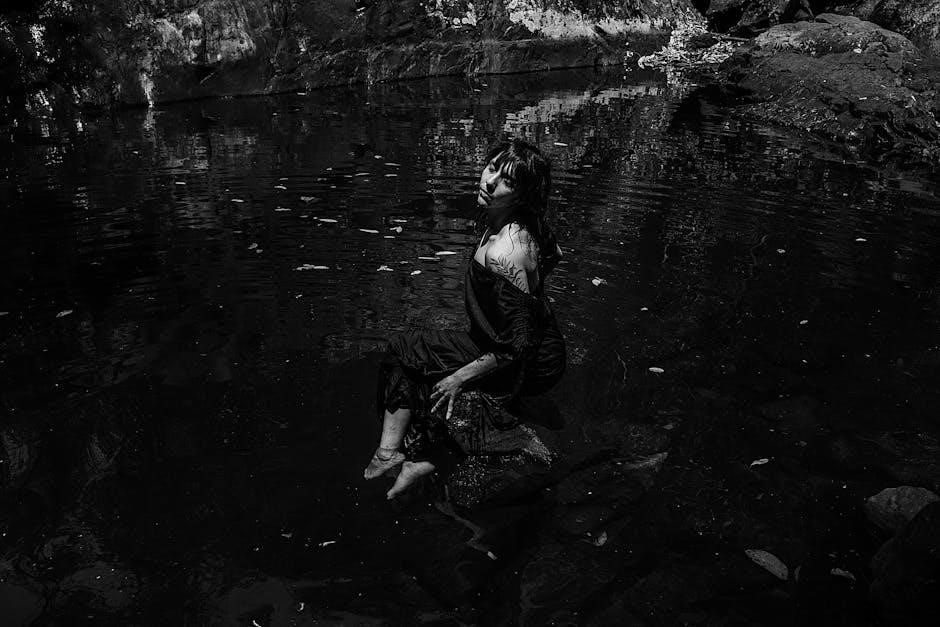Sandra Cisneros’ “Woman Hollering Creek” is a poignant tale of love, identity, and resilience, centered on Cleófilas’ journey through marriage and self-discovery in a foreign land.
The story explores themes of love, disillusionment, domestic violence, and cultural identity, reflecting the struggles of Mexican-American women navigating tradition, self-discovery, and societal expectations.

Themes in “Woman Hollering Creek”

Love and Disillusionment
Cleófilas’ journey in “Woman Hollering Creek” delves deeply into the complexities of love and disillusionment. She initially envisions a romantic marriage inspired by telenovelas, yet reality unfolds differently. Her husband, Juan Pedro, turns out to be abusive, shattering her idealized notions of love. Despite the physical and emotional abuse, Cleófilas clings to her love, revealing a tragic interplay between enduring affection and harsh reality. This theme reflects the struggles many women face in reconciling romantic ideals with the brutal truths of their circumstances, highlighting the resilience and sometimes painful endurance required in such relationships.
Domestic Violence
Domestic violence is a central theme in “Woman Hollering Creek,” as Cleófilas endures physical and emotional abuse from her husband, Juan Pedro. The narrative vividly portrays her isolation and suffering, emphasizing the oppressive nature of her marriage. Juan Pedro’s controlling behavior and verbal cruelty trap Cleófilas in a cycle of fear and dependency. The story highlights the societal norms that often silence women, making it difficult for Cleófilas to escape her abusive relationship. Cisneros uses this portrayal to critique patriarchal systems and give voice to the struggles of marginalized women. Through Cleófilas’ resilience, the story underscores the strength needed to survive such circumstances and the importance of community support in breaking the cycle of violence. This theme remains a powerful commentary on the realities faced by many women in similar situations.
Cultural Identity

Cultural identity is a profound theme in “Woman Hollering Creek,” as Sandra Cisneros explores the complexities of being a Mexican-American woman. The story delves into the tension between traditional Mexican heritage and the realities of living in Texas. Cleófilas’ journey reflects the struggle to maintain her cultural roots while adapting to a new environment; The creek itself, with its mysterious name tied to the legend of a weeping woman, symbolizes the blending of folklore and personal identity. Cisneros highlights how cultural narratives shape individual experiences, particularly for women navigating dual identities. The story emphasizes the importance of preserving cultural heritage while forging a sense of belonging in a changing world. This theme resonates deeply, offering a powerful exploration of identity, tradition, and resilience.
Identity Formation
In “Woman Hollering Creek,” Sandra Cisneros intricately explores the process of identity formation through Cleófilas’ experiences. Her journey from a romanticized notion of marriage to the harsh realities of domestic life forces her to reevaluate her sense of self. The creek, with its mysterious name, serves as a symbol of transformation, reflecting Cleófilas’ evolving understanding of her own identity. Through her interactions with her neighbors and her reflections on her past, she begins to reclaim her voice and agency. The story highlights how identity is shaped by personal struggles, cultural influences, and the resilience of the human spirit. Cleófilas’ journey is not just a story of survival but also one of self-discovery, where she learns to define herself beyond societal expectations and marital roles.

Characters in “Woman Hollering Creek”
The story centers on Cleófilas, a young woman navigating marriage and identity, alongside her abusive husband Juan Pedro and supportive neighbors who share their own struggles.
Cleófilas
Cleófilas Enriqueta DeLeon Hernandez is the protagonist, a young woman who leaves her father’s home in Mexico to marry Juan Pedro. Idealizing romance, she faces a harsh reality of domestic abuse and isolation in Texas. Her journey reflects the struggle for self-discovery and resilience. Through her experiences, Cisneros portrays the challenges faced by Mexican-American women, blending cultural identity with personal growth. Cleófilas’ story is a powerful exploration of love, loss, and the search for identity in a foreign environment.
Juan Pedro
Juan Pedro Martinez Sanchez is Cleófilas’ husband, initially seen as a charming suitor who sweeps her off her feet. However, their marriage reveals his true nature: controlling, emotionally distant, and physically abusive. His actions contrast sharply with Cleófilas’ romantic ideals, shaped by Mexican telenovelas. Despite his cruelty, Cleófilas initially tries to reconcile her love for him with the harsh reality of their relationship. Juan Pedro’s character embodies the societal expectations of masculinity and the toxic dynamics that can emerge in traditional marriages. Through his portrayal, Cisneros critiques the violence and emotional detachment that many women endure in their relationships, making him a pivotal figure in Cleófilas’ journey toward self-awareness and liberation.
The Neighbors
The neighbors in “Woman Hollering Creek” serve as a source of support and connection for Cleófilas, offering her a sense of community in her isolated life. They share their own stories of hardship, including experiences of abuse and resilience, which resonate deeply with Cleófilas’ struggles. These women provide emotional validation and practical advice, helping her navigate her tumultuous marriage and cultural displacement. Their presence contrasts sharply with Juan Pedro’s cruelty, highlighting the importance of female solidarity. Through their interactions, Cisneros emphasizes the power of shared experiences and the ways in which women can uplift one another in the face of adversity. The neighbors embody a collective strength that aids Cleófilas in her journey toward self-realization and liberation.
Narrative Style in “Woman Hollering Creek”
Cisneros employs a lyrical, poetic prose, blending vivid imagery with emotional depth. The story uses first-person narration and symbolic elements to convey Cleófilas’ inner world and cultural duality.
Storytelling Techniques
Sandra Cisneros employs a unique blend of first-person narration and flashbacks to weave the story of Cleófilas, creating an intimate connection with the reader. The narrative jumps between her idyllic childhood memories and her harsh reality, emphasizing the contrast between illusion and truth. Cisneros also uses dialogue to reveal the inner lives of characters, particularly the shared experiences of women in the community. The story’s non-linear structure mirrors Cleófilas’ fragmented thoughts, reflecting her emotional turmoil. Additionally, the author incorporates symbolism, such as the creek, to represent both sorrow and liberation. This layered approach enriches the narrative, making it a powerful exploration of love, identity, and resilience.
Use of Symbolism
Sandra Cisneros masterfully uses symbolism in “Woman Hollering Creek” to convey deeper emotional and cultural themes. The creek itself is a central symbol, representing both sorrow and liberation. Its name, tied to the legend of a woman’s cries, echoes the pain and resilience of the female characters. The creek also serves as a dividing line between Cleófilas’ past and present, symbolizing her journey of self-discovery. Additionally, the recurring imagery of sunlight and darkness contrasts the idealized romance of telenovelas with the harsh realities of her marriage. These symbols not only enrich the narrative but also highlight the duality of love and suffering, making the story a profound exploration of identity and endurance.
Cultural Significance of “Woman Hollering Creek”
The story reflects Mexican-American cultural identity through themes of tradition, modernity, and resilience, giving voice to marginalized women and preserving cultural heritage while addressing contemporary issues.
Mexican-American Culture
“Woman Hollering Creek” vividly portrays the complexities of Mexican-American culture through Cleófilas’ experiences, blending traditional values with the realities of life in a new environment.
The narrative highlights cultural duality, where characters navigate between their Mexican heritage and American influences, creating a rich tapestry of identity.
Cisneros’ storytelling weaves in elements of folklore, such as the La Llorona myth, to explore themes of love, loss, and resilience.
This cultural blend is central to the story, offering insights into the struggles and triumphs of Mexican-American women.
By giving voice to these experiences, Cisneros bridges gaps between generations and cultures, fostering understanding and connection.
The creek itself becomes a symbol of cultural intersection, reflecting the flow of traditions and the adaptation to new realities.
Through this lens, the story becomes a powerful exploration of identity, community, and the enduring strength of cultural heritage.
La Llorona Myth
The story of “Woman Hollering Creek” draws parallels to the enduring La Llorona myth, a timeless Mexican folktale of a grieving mother haunting rivers.
In Cisneros’ narrative, the creek’s name evokes the legend, symbolizing a woman’s outcry—whether from sorrow, rage, or resilience.
La Llorona’s ghostly figure, weeping for her lost children, mirrors Cleófilas’ emotional journey and her struggles with love and abandonment.
The myth adds a layer of cultural depth, connecting the protagonist’s experiences to a broader tradition of female suffering and strength.
By invoking this myth, Cisneros highlights the universal themes of loss and survival, resonating deeply with readers familiar with the legend.
The creek becomes a symbolic bridge between folklore and reality, underscoring the enduring power of cultural narratives in shaping identity.
This interplay enriches the story, offering a poignant reflection on love, loss, and the female experience.

Impact and Legacy of “Woman Hollering Creek”
Sandra Cisneros’ “Woman Hollering Creek” has left a lasting impact, resonating deeply with readers and becoming a cornerstone of Chicana literature and feminist discourse worldwide.
Reception
“Woman Hollering Creek” received widespread acclaim for its vivid storytelling and emotional depth. Critics praised Sandra Cisneros’ ability to weave cultural identity and personal struggles into a compelling narrative. The story resonated deeply with readers, particularly for its unflinching portrayal of domestic violence and the resilience of women. It has been widely adopted in educational curricula, fostering discussions on gender, identity, and cultural heritage. The narrative’s raw honesty and poetic prose earned it a place as a cornerstone of Chicana literature, celebrating the voices of marginalized women and their complex lives. Its impact continues to grow, solidifying its legacy as a powerful exploration of human experience and cultural identity.
Lasting Legacy
Sandra Cisneros’ “Woman Hollering Creek” has left an indelible mark on Chicana literature, becoming a cornerstone of cultural and feminist discourse. Its exploration of identity, violence, and resilience continues to resonate, inspiring new generations of writers and scholars. The collection is frequently studied in academic settings, fostering dialogue on gender, race, and cultural heritage. Its impact extends beyond literature, influencing broader conversations about marginalization and empowerment. The story’s ability to blend personal and collective narratives has cemented its place as a foundational text, ensuring its relevance for years to come. Its legacy lies in its unflinching portrayal of women’s lives and its contribution to the rich tapestry of Mexican-American cultural expression.
